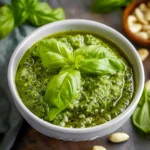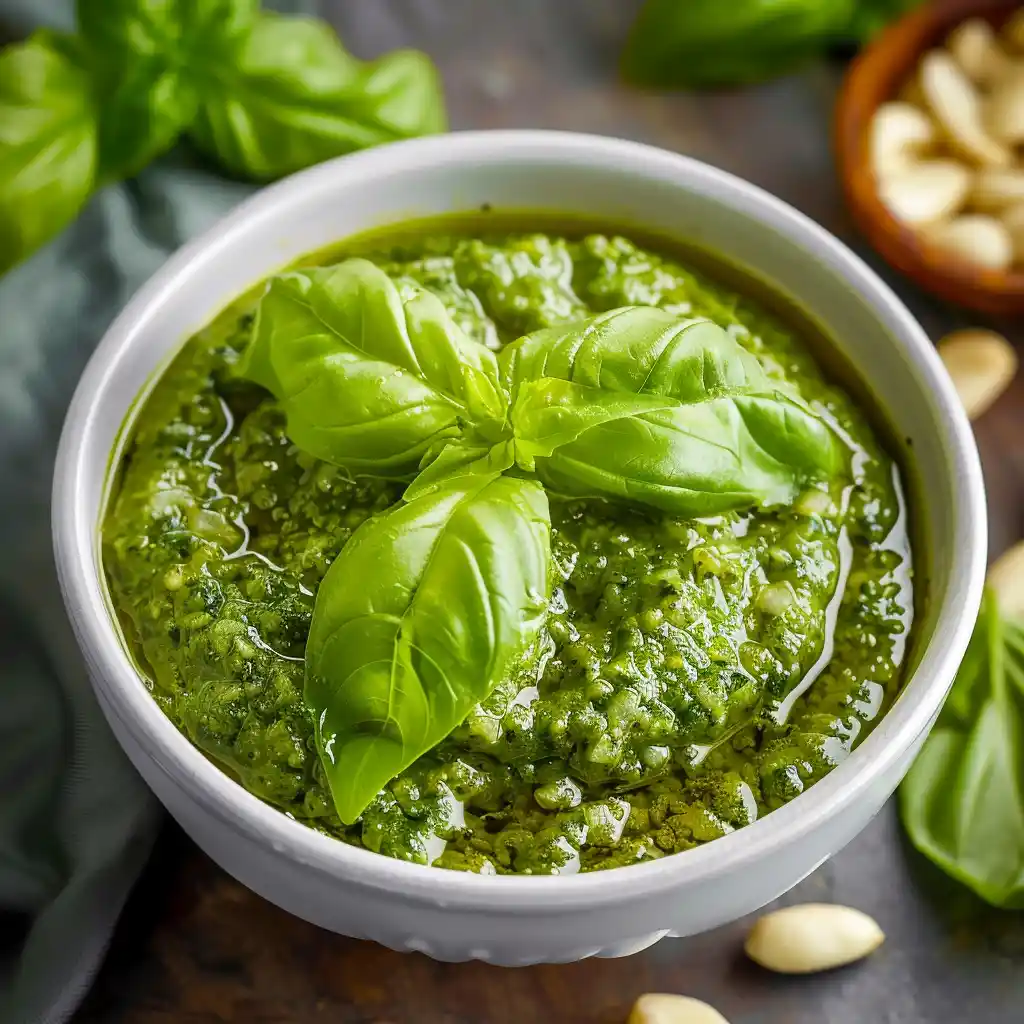This classic Italian basil pesto recipe delivers bright, herbaceous flavors in just minutes of preparation. Dating back to Genoa in northern Italy, traditional pesto combines the region’s finest ingredients – fragrant basil, pine nuts, garlic, and Parmesan – into a versatile sauce that captures the essence of Mediterranean cuisine. This simple homemade version stays true to authentic techniques while being accessible enough for any home cook to master.
Why You’ll Love This Recipe
- Ready in less than 5 minutes with minimal equipment – just a food processor and basic ingredients
- Vibrant, fresh flavors that far surpass any store-bought alternatives
- Incredibly versatile – perfect for pasta, sandwiches, soups, proteins, and more
- Customizable consistency to suit your personal preference – from chunky to smooth
- Made with wholesome, natural ingredients that create a harmonious balance of flavors
Ingredients
- Fresh Basil Leaves: Choose large, vibrant green leaves with no spots or wilting. The fresher the basil, the more aromatic your pesto will be.
- Garlic: Fresh cloves provide the perfect punch of flavor; adjust quantity based on your preference for garlic intensity.
- Pine Nuts: These buttery nuts are traditional in pesto and provide richness. Toast them lightly for enhanced flavor if desired.
- Parmesan Cheese: Freshly grated Parmigiano-Reggiano offers the best flavor, but pre-grated works in a pinch. The cheese adds saltiness and depth.
- Black Pepper: Freshly ground provides superior flavor compared to pre-ground varieties.
- Maldon Salt: This flaky sea salt has a clean taste that enhances without overwhelming. The texture dissolves beautifully in the sauce.
- Olive Oil: Use a good quality extra virgin olive oil for the best flavor profile. The oil binds everything together and creates the perfect consistency.
Variations
Nut-Free Pesto
Replace pine nuts with sunflower seeds or pumpkin seeds for an equally delicious but allergen-friendly version. The texture will be slightly different, but the flavor profile remains bright and herbaceous.
Budget-Friendly Pesto
Substitute walnuts or cashews for the more expensive pine nuts. These alternatives provide a similar richness at a fraction of the cost. You can also use half basil and half baby spinach to stretch your basil supply.
Dairy-Free Pesto
Skip the Parmesan and add nutritional yeast for a similar umami flavor, or use a dairy-free Parmesan alternative. Increase the salt slightly to compensate for the missing cheese saltiness.
How to Make the Recipe
Step 1: Prepare the Base Ingredients
Add the fresh basil leaves, peeled garlic cloves, pine nuts, freshly grated Parmesan, ground black pepper, and Maldon salt to your food processor. Pulse for approximately 10 seconds to break down the garlic and pine nuts. This brief pulsing ensures the ingredients are broken down without becoming too fine too quickly.
Step 2: Incorporate the Olive Oil
With the food processor running, slowly pour the olive oil through the feed tube in a steady stream. This should take about 10 seconds. Adding the oil gradually allows it to properly emulsify with the other ingredients, creating a cohesive sauce rather than a separated mixture.
Step 3: Adjust Consistency and Seasoning
Check the texture of your pesto – if you prefer a chunkier consistency, it’s ready to use. For a smoother pesto, process for an additional 10-20 seconds until you reach your desired texture. Taste and adjust seasoning as needed, adding more Maldon salt if desired. The final touch of crushed Maldon salt enhances all the flavors and brings the pesto to life.
Tips for Making the Recipe
- Slightly toast the pine nuts in a dry pan before adding them to enhance their nutty flavor
- Use only the leaves of the basil, not the stems, for the smoothest texture and best flavor
- If you plan to store the pesto, add a thin layer of olive oil on top to prevent oxidation and maintain the vibrant green color
- For brighter green pesto, blanch the basil leaves for 5-10 seconds in boiling water, then immediately plunge into ice water before using
- Avoid over-processing the pesto as it can become too smooth and paste-like – short pulses give the best texture
- Allow the pesto to sit for 30 minutes before serving to let the flavors meld together
How to Serve
This versatile pesto can elevate numerous dishes. Toss with hot pasta (reserve some pasta water to help the sauce cling to the noodles), spread on crostini or sandwiches, stir into soups, or use as a marinade for chicken or fish. For an elegant presentation, drizzle over caprese salad or swirl into risotto just before serving. The bright green color makes it visually appealing as both a component and garnish. For pasta dishes, consider adding a few extra pine nuts and Parmesan shavings on top before serving.
Make Ahead
This pesto can be prepared up to 3 days in advance and stored in an airtight container in the refrigerator. To prevent discoloration, press plastic wrap directly onto the surface of the pesto or pour a thin layer of olive oil on top before sealing. For longer storage, freeze pesto in ice cube trays, then transfer the frozen cubes to a freezer bag where they’ll keep for up to 3 months. Thaw in the refrigerator overnight or add frozen cubes directly to hot dishes. The pesto may separate slightly upon thawing – simply stir to recombine.
FAQs
Can I freeze pesto?
Yes! Freeze pesto in ice cube trays, then transfer the frozen cubes to a freezer bag. This allows you to use small portions as needed. Frozen pesto maintains good quality for up to 3 months.
Why did my pesto turn brown?
Basil oxidizes when exposed to air, similar to how apples brown. To prevent this, add a thin layer of olive oil on top when storing, or add a small amount of lemon juice to the recipe, which helps maintain the vibrant green color.
Can I substitute different herbs for basil?
Absolutely! Try substituting part or all of the basil with other herbs like parsley, cilantro, mint, or arugula. Each will create a distinct flavor profile while maintaining the basic structure of the sauce.
How can I make my pesto less strong/intense?
For a milder flavor, reduce the amount of garlic and use baby spinach to replace some of the basil. You can also blanch the garlic for 30 seconds before using to reduce its pungency.
Conclusion
This simple homemade pesto recipe delivers authentic Italian flavors with minimal effort. The combination of fresh basil, pine nuts, garlic, and Parmesan creates a versatile sauce that transforms ordinary dishes into something special. Whether tossed with pasta, spread on sandwiches, or used as a flavor enhancer for proteins, this pesto will become a staple in your culinary repertoire. The best part? It comes together in minutes but tastes like you spent hours crafting the perfect balance of flavors. Give this recipe a try and discover how a simple sauce can elevate your everyday cooking to restaurant quality.
Print
Simple Pesto Recipe
- Total Time: 5 minutes
- Yield: About 1 cup 1x
- Diet: Vegetarian
Description
A vibrant and aromatic fresh basil pesto made with pine nuts, garlic, and Parmesan cheese. This classic Italian sauce comes together in minutes and adds incredible flavor to pasta, sandwiches, and more.
Ingredients
- 50g (1.75oz) fresh basil leaves
- 2 cloves garlic, peeled
- 40g (3 tbsp) pine nuts
- 30g (1/3 cup) freshly grated Parmesan
- ¼ tsp freshly ground black pepper
- ¼ tsp Maldon salt
- 90ml (1/3 cup) olive oil
- To Serve:
- ½ tsp crushed Maldon Salt
Instructions
- Combine Dry Ingredients: Add the basil, garlic, pine nuts, Parmesan, black pepper, and salt to a food processor and pulse for about 10 seconds. This initial pulsing breaks up the garlic and pine nuts while beginning to release the aromatic oils from the basil leaves, creating the foundation of your pesto.
- Add Oil: Turn the food processor back on and pour in the olive oil in a steady stream, which should take about 10 seconds. Adding the oil gradually while the processor is running helps create an emulsion that gives the pesto its smooth, cohesive texture while preventing it from separating.
- Check Consistency: Examine the pesto for your preferred texture. If you enjoy a chunkier pesto with more defined bits of basil and pine nuts, it’s ready to serve. If you prefer a smoother consistency, continue processing for another 10-20 seconds until you achieve your desired texture.
- Adjust Seasoning: Taste the pesto and add more salt if needed. Adding approximately ½ teaspoon of lightly crushed Maldon salt at the end enhances all the flavors and brings the sauce to life.
Notes
- Fresh pesto will keep in the refrigerator for up to 5 days when stored in an airtight container with a thin layer of olive oil on top to prevent oxidation.
- To freeze pesto, portion it into ice cube trays, freeze until solid, then transfer the cubes to a freezer bag. This way, you can thaw only what you need.
- For a nut-free version, substitute sunflower seeds or walnuts for pine nuts.
- Traditional Ligurian pesto also includes a small amount of pecorino cheese along with the Parmesan.
- For a more authentic touch, try using a mortar and pestle instead of a food processor.
- Prep Time: 5 minutes
- Cook Time: 0 minutes
- Category: Sauces-condiments
- Method: No-cook
- Cuisine: Italian
Nutrition
- Serving Size: 1 tablespoon
- Calories: 80
- Sugar: 0g
- Sodium: 120mg
- Fat: 8g
- Saturated Fat: 1g
- Unsaturated Fat: 7g
- Trans Fat: 0g
- Carbohydrates: 1g
- Fiber: 0g
- Protein: 1g
- Cholesterol: 2mg


